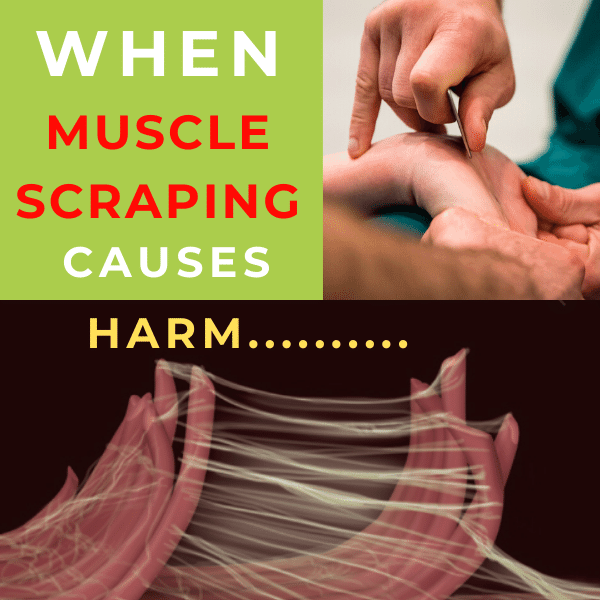
18 Jan When Muscle Scraping Causes Harm
You’ve been muscle scraping, have you?
Or maybe the chiropractor, physical therapist, or massage therapist you’re seeing uses muscle scraping.
You think to yourself:
- “Redness is good.”
- “No matter what I feel, I’ll just do some muscle scraping after the workout and that’ll fix me.”
- “If there’s pain or tightness during the workout, I’ll just muscle scrape before the next workout.”
- “I can do no harm with muscle scraping.”
What if you COULD DO HARM?
Let’s dive into the GOOD and BAD around muscle scraping.
Why bother muscle scraping?
Most athletes don’t want to STOP doing their beloved activity.
Chances are, whether you play a sport, CrossFit, run, do triathlons, Orangetheory, spin, or yoga, the thought of having to give up your activity is a non-negotiable.
At Barefoot Rehab in Denville, NJ, where we specialize in permanent pain relief for people in chronic pain, it’s very common for chronic pain sufferers to get anxiety or depression after giving up the activities they love to do.
Remember Sy Sperling from Hair Club for Men?
Remember, I’m not only the Hair Club President, but I’m also a client. ~Sy Sperling
Similarly…
I’ve had to stop playing rugby and doing CrossFit due to injuring myself over and over again.
I’m not only the Clinic Director of Barefoot Rehab, but I have chronic pain and depression too. ~Me
Let’s be honest.
Your GENERAL goal for muscle scraping is this:
To continue doing your favorite thing AS LONG AS POSSIBLE.
You muscle scrape to make your tightness or pain go away so you can workout TODAY.
You don’t realize that the way you’re muscle scraping will take away your ability to workout in the metaphorical TOMORROW.
At some point, if you neglect PRIMARY PROBLEMS, your problem will cause enough pain that it stops you from working out.
It might be in a few weeks, months, or even 2-3 years.
But you’re guaranteed to STOP working out sooner than you want to if you blindly muscle scrape yourself.
Instead, if you’re going to muscle scrape, it needs to be for a SPECIFIC PURPOSE.
Muscle Scrape to get PERMANENT Results
To get muscle scraping done in an EFFECTIVE, SAFE way that achieves your GENERAL goal: You must have less tightness or pain progressively over 5 “treatments” or over a 17 day period.
Having an expectation for what’s possible allows you to know when you’re potentially risking permanently damaging a joint.
- No permanent pain or tightness relief in 5 visits or less? High Risk.
- Any incremental relief in pain or tightness in 5 visits or less? Low Risk.
This is why at Barefoot Rehab, we have a 5 Visit Rule.
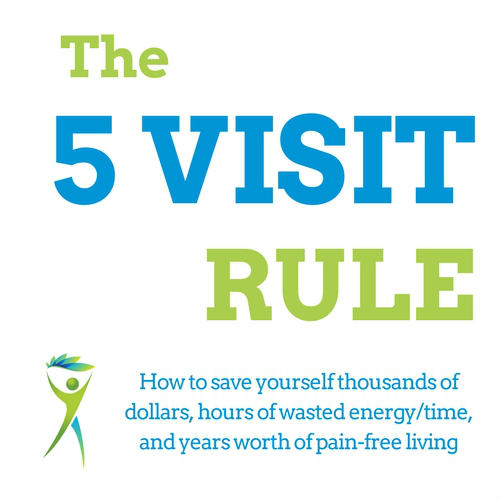
EVERY SINGLE tightness or pain intervention you might get must respect the 5 Visit Rule.
If you don’t have at least 5% permanent relief in tightness or pain, STOP THE INTERVENTION.
Sometimes at the clinic, we’ll get a patient who has been stretching their hamstrings for years.
When we ask them:
How much more flexible are you from all of that stretching? How long are you flexible for after stretching?
They get this puzzled look on their face and respond after a 10 second pause:
I’m loose for 10 minutes before it tightens up again.
Facetiously, I say:
Can we agree that you need to stop stretching your hamstrings now? It’s not working. There’s no sustained result.
We won’t even go into how static stretching displays ZERO injury prevention effects.
Having an expectation allows you to modify behaviors accordingly.
Now, you know what your purpose SHOULD be when muscle scraping or even stretching.
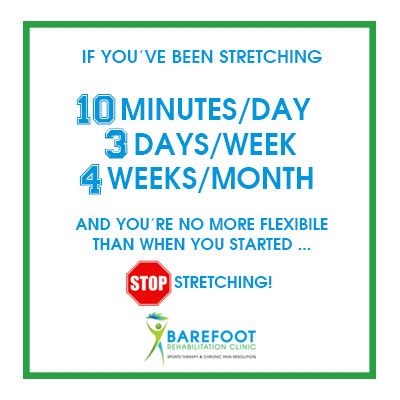
So you don’t have to waste your time, energy, or money.
Can You Muscle Scrape Yourself?
In theory, yes.
In my biased opinion, Integrative Diagnosis doctors and therapists are the best in the world at manual therapy.
- Manual therapy: the use of hands or instruments to get permanent changes in tightness or pain
While I do treat my own forearms and feet, it’s very difficult to do and it often comes at the cost of irritating my skin.
If it’s hard for me to do with over 10 years of training, it’ll be nearly impossible for you to muscle scrape yourself.
A few months ago, we had a patient from Virginia drive up to New Jersey for a week of treatment with us.
He was trying to muscle scrape his own hamstring tendinosis.
I explain why it’s physically impossible to muscle scrape your own hamstring tendons below.
He wasn’t able to feel any grit!
For an individual holding an instrument to feel grit AND contort their body in a way that puts enough TENSION on it so the adhesion can be torn, they’d have to be a circus monkey.
The body just doesn’t move in a way that you can fulfill the purpose you’re trying to achieve.
It’ll likely be dead silent when muscle scraping yourself.
There’s a specific sound you should be looking for when muscle scraping.
What Muscle Scraping Is FIXING
To muscle scrape effectively, the person holding the instrument MUST feel grit.
Otherwise, you’re putting pressure on the target tissue and that’s merely bringing blood flow with your pressure. Pressure doesn’t bring permanent changes.
To feel grit, there needs to be tension on the targeted muscle.
If you’re not sure what I mean by tension, check out this RUBBER BAND.
The grit you or your manual therapist MUST feel is evidence of the most common cause of chronic pain and tightness in the body.
It’s kinda like glue in the muscles called ADHESION.
I’ll argue that almost any muscle scraping you undergo should be for the purpose of breaking adhesion.
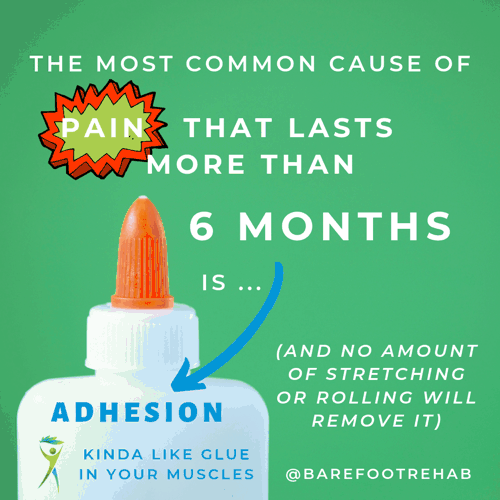
When the adhesion is really bad and the instrument is treats effectively, it’ll sound pretty gross.
Many people liken it to “nails on a chalkboard.”
It’s possible that you might NOT HEAR the grit.
The main determining factor of effective muscle scraping is the FEEL of grit by the person who has the instrument in his/her hand.
There are certain locations that can’t be treated effectively with an instrument, no matter the practitioner’s skill level.
Muscle Scraping Removes ADHESION When 1″ Close to the Skin
There are rules that must be followed to get effective muscle scraping to tear out adhesion.
Most importantly, the ADHESION must be within 1″ of the skin.
It’s NOT physically possible to treat:
- the psoas under your intestines
- longus coli under your trachea
- subscapularis under all of your armpit skin.
Treatment to these tissues will only irritate the skin and can potentially damage more sensitive tissues.
Remember, you want to treat ONLY the adhesion.
There’s no need to “paint your body part red” the way many gua sha practitioners do, damaging healthy tissue.
Eastern philosophy healers traditionally made a large region of your body red to induce a fever.
You DO NOT need a fever to get permanent pain relief.
You DO NEED to get the adhesion removed, and only the adhesion.
A tissue that often has lots of adhesion in chronic low back pain sufferers, responds extremely well to “muscle scraping” and hardly at all to manual therapy done by hand isn’t even a muscle at all.
It’s the size of a piece of angel hair pasta.
A ligament called the supraspinous ligament in the lumbar spine.
When adhesed, this ligament creates a nutcracker effect on your lumbar discs, greatly increasing the stress on them.
No amount of muscle work will help your chronic low back pain if the supraspinous ligament has significant adhesion.
The best thing about using muscle scraping effectively?
Flexibility increases and sustained pain relief often happens IMMEDIATELY!
Rules for Effective Muscle Scraping
Remember, your big picture goal is longevity.
You want to do your activity as long as possible.
Your specific goal when muscle scraping is to remove adhesion and noticing permanent changes that last.
To muscle scrape effectively:
- Respect the 5 Visit Rule and observe at least 5% relief in pain or tightness in 5 “treatments” or less.
- Don’t muscle scrape yourself.
- Get a skilled Integrative Diagnosis doctor/therapist to perform Instrument Adhesion Release on you.
- Make sure you feel and hear grit.
- The muscle (or tissue) must be within 1″ of the skin.
Follow these rules and you can expect to be working out 30 years from now.
Break them at your own peril.
If you have chronic tightness or pain that hasn’t gone away in over 6 months and you’ve already seen at least 3 doctors or therapists, Barefoot Rehab in Denville, NJ, is the ONLY clinic in New Jersey certified to find and fix adhesion. Give us a call at 862-205-4847 to see if you’re a candidate for the PERMANENT pain relief we offer our patients.
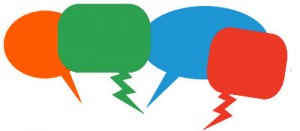 What has your experience been with muscle scraping? Share in the comments below.
What has your experience been with muscle scraping? Share in the comments below.

Bowen
Posted at 17:59h, 20 May“I am trying to help but to the point where I will benefit” … That’s what I read.
Things you could have said:
– Areas you can scrape yourself and areas you can’t
= How to scrape correctly and what not to do
Scraping is an amazing way for someone to break up scar tissue and break down fascia. Scraping as a quick fix can be good but if the problem persists then the issue is only being bandaged, you need to get more clear help!
Eileen Wagner
Posted at 21:52h, 15 SeptemberAfter total knee replacement, my PT has scraped my thigh (up to my panty line), the outside of my knee, and the ITB. Originally, I was told the pain was from muscles and ligaments finding the their ways home. Then I was vaguely told it was scar tissue. I question the necessity of scraping the band as the procedure actually makes me cry and I have lots of pain for a few days afterwards. The PT assures me that’s a normal response. Ummm … what do you think?
Dr. Chris
Posted at 14:46h, 16 SeptemberTreatment shouldn’t be that painful. Although you would have a little more pain due to knee replacement. I’d be spending more time on your sciatic nerve, hams, calves, and feet as those tissues are likely adhesed and the ITB is likely overactive.
Ray Pasquale
Posted at 13:50h, 26 OctoberMy son had tommy john surgery and is in month 6 of rehab. The PT is doing a lot of work to strengthen his shoulder. His thought is he has not used those muscles and wants to help prevent any injuries when he starts throwing fully. Makes sense to me. He mentions scrapping his shoulders as from therapy he is very tight and sore. What are your thoughts?
Dr. Chris
Posted at 23:10h, 27 OctoberHi Ray, Yes treating the shoulder, arm, forearm, and hand would be helpful to return to normal mechanics. In my experience, scraping works really well for the forearm but horribly for the shoulder. The reason is because the trap is over the rotator cuff muscles and therefore, you can’t get good grit with an instrument. But if it’s improving his range every single visit, then it must be working.
Sonia Correia - Turnbull
Posted at 12:55h, 31 JanuaryIs it normal for the back to go into spasms after muscle scraping?
Dr. Chris
Posted at 13:01h, 02 FebruaryMuscle spasms are never normal. You likely overloaded a spinal/disc segment. This is a good example of when “muscle scraping causes harm”
Concerned Coach
Posted at 17:12h, 05 MarchI am a coach. One of my tennis players is having soreness in primary arm in the lower bicep area, only after excessive practice or match play. No ligament tears for substantial injury as of yet. The trainer has been performing, what I believe to be experimental, scraping to help the soreness. The player has substantial light bruising on the entire bicep area that is being scraped, from elbow to the upper bicep. What should I be concerned about with this procedure? Is this a proven technique, because I have been an athlete and a Coach my entire life and through my own injuries and players injuries, I have never heard of this technique. Is the bruising common, or are my trainers not doing this correctly? Is this a good way, or proper way to treat simple soreness of muscles after workouts?
Dr. Chris
Posted at 17:22h, 05 MarchIt depends how the technique is being applied. It might help. Or it might cause harm. Bruising is common when it’s excessively applied. Even if it’s properly applied, there could be some bruising. Yes, it can help with soreness and can help with the tissue recovery.
Ken Leek
Posted at 22:36h, 17 MarchI just wish I could find a therapist who wasn’t in a mad rush to move me in and out as fast as possible with the majority of their time on their laptop as I do pointless exercises I could easily do at home. If I’m not perfect in six weeks, out the door I go. It’s a whole lot of money for nothing. Every time I look up how to help myself it’s stated it can’t be done without the help of professionals. Cool. Where are they? Oh, that’s right. Nowhere except in Wealthy Person Land.
Dr. Chris
Posted at 20:58h, 18 MarchI’m so sorry for your experience Ken. Unfortunately, our healthcare system isn’t great at actually helping people heal. Where do you live? Maybe I have colleagues near you.
Medical Melissa
Posted at 06:20h, 10 AprilSo, in my experience more knowledge is never a bad thing. Here is some your PT is not likely to tell you. I only know because I almost have my masters in OT. I also happen to have A LOT of experience as a patient. Just had my 9th pelvic surgery and I’m only 33. PTs have productivity demands. For example: That means that whatever company ends up covering their treatment believes they should be working directly with a patient 95% of the time spent working. What they don’t factor in is the enormous amount of things that MUST be done, but that are hands off. Notes, updates, patient education. Etc. So how do therapists fit everything in?? Especially considering they aren’t supposed to work overtime finishing notes or take notes home. The solution for many is exactly what you described. Also know that a therapist will see much more than the average person. My dad hurt his back, was doing his seeming simple exercises… thought he had them totally covered. I took one look at him and knew he didn’t. He wasn’t even breathing correctly. So whatever therapist you saw saw much more in you than you saw in her. That being said, it is NOT a good solution and really shouldn’t be done. It’s not good practice, but companies have made it almost a requirement. However please do not hesitate to voice your concerns. If you don’t feel you’re getting good treatment tell them. Ask if while you’re with them they can do more hands on stuff so you can do the other things at home. You have to advocate for yourself. If you do so abs still see no improvement… switch physicians. My mom saw someone expensive who doesn’t the entire time gossiping with her co-workers. She REALLY should have said something. And that was with a note expensive place the doctor himself recommended (after i made my mom ask about it in the first place). Terrible expensive doctor and because she went along with it abs said nothing, her foot is worse. So, if you think you shouldn’t bother with advocacy or looking for treatment elsewhere because it will be the same everywhere… that is wrong. And although you can great treatment paying out of pocket, my mom and I both have had horrible experiences doing so. I once had a world renowned gyn diagnose me with something he didn’t even examine for and that it turns out I don’t have. He also did a lot of other horrible stuff. Know you diagnosis so you can ask the right questions. Look for a doctor is OK working with others and isn’t afraid to say they don’t know something. Look for ones that are open minded. That’s much better than once who assumes they know everything and only think inside the box. My current team is made up of people like that and not one of them is private pay. They all accept almost every insurance there is. Occasionally there is the odd specialist that is so specialized insurance does not see the justification in covering them. If you really need to see them, ask if they will do a consult and would be willing to work with your normal, more affordable physicians. Many are happy to do so. And where possible, get referrals from a trusted physician. It usually works out better than just trying to find someone on your own, but make sure the referring physician is actually good and really knows your case before taking their referral. But doing this also means your therapist and physician will already have a good working relationship, that is always a plus! The real problem with Healthcare is that you have businessmen and politicians making Healthcare decisions despite 0 understanding of the subject. That is where your frustration should lie. Please understand that your quality of care is partially a direct result of that. Sometimes with advocacy and understanding on BOTH sides it is fixable. If it isn’t, change physicians. But like I said, part of this is understanding on your end. Even with the best care, your healing time may vary. You might not be better in 6 weeks. Speak to your team about realistic healing times and recovery goals. And if you aren’t better by then, it still isn’t always treatment. I basically broke both knees walking down a hallway. Was not healing quickly, but it had nothing to do with my quality of care. I have a rare genetic condition that negatively impacts healing and generally causes chaos throughout my entire body. Though I suspected it years prior- I do my research, abs it not just webmd-(and yes… i did mention it to my then Dr. … thanks Dr. I know everything for NOT listening to me and causing years of frustration) that knee injury is what finally got me to a geneticist for a proper diagnosis. Didn’t matter how much PT I got or who from. It healed when it wanted to. So know your body, know your diagnosis, know how the Healthcare system really works so you can work it, have realistic goals and expectations, and if you think something isn’t right, say something. Please know I’m not saying any of this from a place of arrogance, I’ve just been around the block and have a lot of medical training myself. Many therapists are really trying to do their best. But I understand your frustration. Completely. I’m with a good team now and i still have to say things every once in a while. It’s stressful to be in Healthcare, but certain offices put more stress on their staff than others. Also take into account that there are certain restrictions and rules they have to follow as well, even if they don’t want to. There is frustration on all ends. But, again, if it isn’t fixable after you try to address it, just look elsewhere. But they aren’t mind readers, you have to voice your concerns and ask questions. Patient education is part of their job. Could be what you think is the silliest question in the world…. doesn’t matter. You have every right to ask it. It’s their job.
I hope this helps. Sorry if I went on was just trying to explain things as well as I could so you are better informed. I wish I was at the start of my health issues. It would have helped. Could write a book with the experiences I’ve had in Healthcare. If not you, then I hope this is helpful to someone. Sorry again that it was long!
Dr. Chris
Posted at 21:00h, 10 AprilTY for your input Melissa. We certainly need to take our healthcare into our own hands.